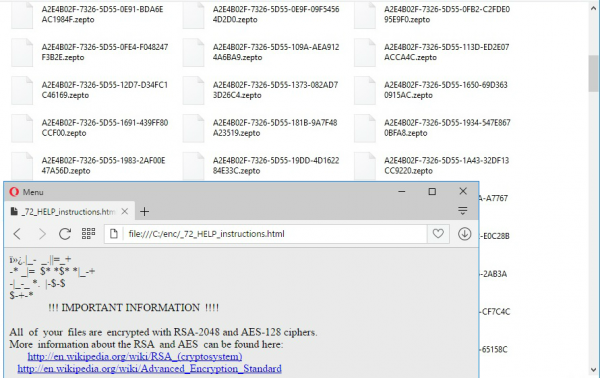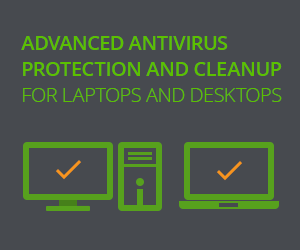Zepto is very similar to the infamous Locky ransomware. Besides, just like any ransoming plague, it wants you to pay in exchange of undoing the damage caused.

The ransomware encodes your data using strong encryption. The science estimates it would take a super computer more time than our Universe exists to calculate the key. That is, the only likely way to get one is to grab it from the holder. These are the black hat hackers who possess the decryption pin. They sell it for 0.5 BTC. Converted to a traditional currency, the amount equals to circa USD 300.
Zepto shares the same payment site with Locky ransomware. Actually, the page title reads ‘Locky Decryptor.’ It refers to Locky in its body. It seems like the crooks have missed aligning the page with Zepto rebranding of Locky virus.
One may wonder how we have learned the infection name. The new strain of ransomware adds .zepto at the end of the scrambled files. Locky ransomware applies the same modification. It appends the .locky extension to the scrambled items. Both infections also scramble the file name proper so that the victims cannot tell one file from another.
Some versions of ransomware offer a trial decryption. This decrypts several files provided by the victims. Scrambling the file names prevents the submission of the most important files. Besides, such a modification further scares the victims and makes them more likely to pay the ransom.
Despite nothing restricts the hackers from applying a wide range of infection vectors, Zepto propagation sticks to email-based fraud. The cyber criminals mass-mail a message with ZIP or DOCM file attached. The body of the message would pretend to be a formal note from sales director or similar typical statement.
The archive contains a JavaScript file. If you open one, it looks like a harmless text file. Once activated, the JavaScript drops the ransomware.
Otherwise, a victim finds a docm file attached. The file has macroses. A victim is supposed to click the prompt to enable the macros that downloads and installs the ransomware.
Once installed, the virus proceeds with encoding any bit of data on your machine. It creates a ransom note which is made available to the unhappy user as a desktop wallpaper, HTML and image file. That instructs the victims to create a bitcoin wallet. 0.5 BTC are to go the hacker’s address in exchange for the decryption key release.
It is essential to get rid of Zepto ransomware. Data recovery is a challenge, but both tasks are equally important. The best practice of ransom-free data recovery and Zepto ransomware removal is available below.
Automatic removal of Zepto ransomware
The benefits of using the automatic security suite to get rid of this infection are obvious: it scans the entire system and detects all potential fragments of the virus, so you are a few mouse clicks away from a complete fix.
- Download and install recommended malware security suite
- Select Start Computer Scan feature and wait until the utility comes up with the scan report. Proceed by clicking on the Fix Threats button, which will trigger a thorough removal process to address all the malware issues compromising your computer and your privacy.
Unlock .zepto files
Zepto represents a unique category of malicious software whose attack surface reaches beyond the operating system and its components, which is why removing the virus itself is a part of the fix only. As it has been mentioned, it encrypts one’s personal information, so the next phase of the overall remediation presupposes reinstating the files that will otherwise remain inaccessible.
-
Launch data recovery software
Similarly to the rest of its fellow-infections, Zepto most likely follows an operational algorithm where it erases the original versions of the victim’s files and actually encrypts their copies. This peculiarity might make your day, because forensics-focused applications like Data Recovery Pro are capable of restoring the information that has been removed. As the virus further evolves, its modus operandi may be altered – in the meanwhile, go ahead and try this.
-
Take advantage of Volume Shadow Copy Service
This technique is based on using the native backup functionality that’s shipped with Windows operating system. Also referred to as Volume Snapshot Service (VSS), this feature makes regular backups of the user’s files and keeps their most recent versions as long as System Restore is on. Zepto virus hasn’t been found to affect these copies therefore the restoration vector in question is strongly recommended. The two sub-sections below highlight the automatic and manual workflow.
- a) Use Shadow Explorer
Shadow Explorer is an applet that provides an easy way of retrieving previous versions of files and folders. Its pro’s include an intuitive interface where the computer’s entire file hierarchy is displayed within one window. Just pick the hard disk volume, select the object or directory to be restored, right-click on it and choose Export. Follow the app’s prompts to get the job done.

- b) Use file properties
Essentially, what the above-mentioned Shadow Explorer tool does is it automates the process that can otherwise be performed manually via the Properties dialog for individual files. This particular approach is more cumbrous but just as effective as its software-based counterpart, so you can proceed by right-clicking on a specific file, which has been encrypted by .crypt ransomware, and selecting Properties in the context menu. The tab named Previous Versions is the next thing to click – it displays available versions of the file by date of the snapshot creation. Pick the latest copy and complete the retrieval by following the prompts.

-
Data backups work wonders
Ransomware like Zepto isn’t nearly as almighty and destructive in case you run regular file backups to the cloud or external data media. The virus itself can be completely removed in a matter of minutes, and the distorted information can then be just as easily recovered from the backup. Luckily, this is a growing trend, so ransom Trojans are hopefully going to become less subversive in the near future.
Verify thoroughness of the removal
Having carried out the instructions above, add a finishing touch to the security procedure by running an additional computer scan to check for residual malware activity
